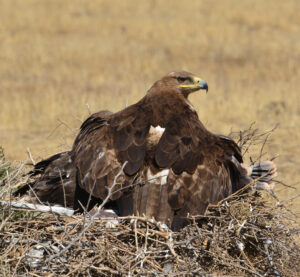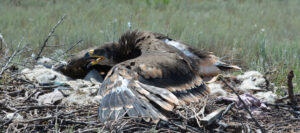Third International Scientific and Practical Conference “Eagles of the Palearctic: Study and Conservation”
Raptors Conservation. Suppl. 2. Proceedings of Conferences
The current state of the Steppe Eagle Population in the Republic of Kalmykia, Russia
Abushin A.A., Erdnenov G.I. (Chornye Zemli (Black Lands) State Nature Reserve, Elista, Russia)
Contact:
Anton Abushin kalmykianbubo@gmail.com
Gennady Erdnenov erdgeil@mail.ru
Recommended citation: Abushin A.A., Erdnenov G.I. The current state of the Steppe Eagle Population in the Republic of Kalmykia, Russia. – Raptors Conservation. 2023. S2: 224–227. DOI: 10.19074/1814-8654-2023-2-224-227 URL: http://rrrcn.ru/en/archives/35038
In the middle of the XX century, the Steppe Eagle (Aquila nipalensis) was almost ubiquitous and abundant in southern Russia. However, due to the total plowing of the steppe, the decline of traditional pasture cattle breeding, the construction of power line infrastructure and other negative factors, the numbers of this species declined everywhere by the end of the XX century. Currently, the Steppe Eagle has practically stopped breeding in Rostov Region and Stavropol Krai, remaining only in the areas bordering Kalmykia in the number of several dozens of pairs. The modern boundary of the continuous breeding range of the Steppe Eagle in Europe is settled on the territory of Kalmykia (789 pairs on average) and the Volgograd Zavolzhye (300– 500 pairs) in the west, going further east to Kazakhstan and to the regions of Russia transboundary with this country. Given the sharp decline in the Kalmyk population of the Steppe Eagle (from 3–10 thousand pairs in the 1980s) and the continuing negative trend, it is important to pay due attention to monitoring and conservation of the westernmost enclave in the more or less integral range of this species in the Eurasian steppes (Karyakin et al., 2016).
We have been conducting annual monitoring of breeding groups of the Steppe Eagle and searching for new nests in the territory of the Republic of Kalmykia since 2021. Two hundred active breeding territories have been identified so far – 25% of the estimated number of the species in the region. According to our estimation, the area of the breeding range of the Steppe Eagle is 47087 km2. However, slightly more than half of this area remains insufficiently and completely unexplored. Due to a prolonged depression in the numbers of the Little Ground Squirrel (Spermophilus pygmaeus), eagles have been nesting irregularly, with relatively low productivity and breeding success, for at least the last few years in a significant part of their range in Kalmykia (75%).
In 2021, the most unsuccessful year in terms of food conditions, the distribution density of occupied breeding territories of eagles was 2.15 (1.54–2.99) pairs/100 km2, and at some registration plots the proportion of nests with dead clutches and nestlings was up to 62%. The rest of the range, which was poorly affected by food depression, showed an increased breeding density of 5.72 (4.45–7.35) pairs/100 km2. In turn, breeding productivity here was 1.5 times higher than on plots with food deficit. In general, the productivity of the breeding groups we studied in 2021–2023 was (n=165) 1.71±0.66 (M±SD) nestlings per successful nest. In our opinion, the main reasons for the prolonged depression of the steppe eagle food objects are unfavorable weather conditions, local lack of pasture load due to a decrease in the number of livestock, as well as active hunting of the Little Ground Squirrel by the local population.
We assume that current breeding rates are insufficient to make up for demographic losses in our population due to high mortality of eagles at breeding territories, on migration routes and wintering grounds. This is indicated by a number of indirect signs such as: an increase in the proportion of young birds in breeding pairs from 5.2% (2015) to 27% (2021), and an increase in the proportion of abandoned breeding territories of 19%. The densification of breeding groups in the core of the population with a simultaneous decrease in the breeding density in the periphery also indicates clearly negative processes. Among negative anthropogenic factors on the territory of Kalmykia the following are recorded: the mass mortality on power lines (in 2022 the remains of 47 steppe eagles were found on 541 km of power lines), undermining of the food base by the local population, disturbance during breeding, taking of nestlings out of the nests by poachers.

Adult Steppe Eagle (Aquila nipalensis) protects its nestlings from the sun in the nest on the ground. Photo by A. Abushin.

